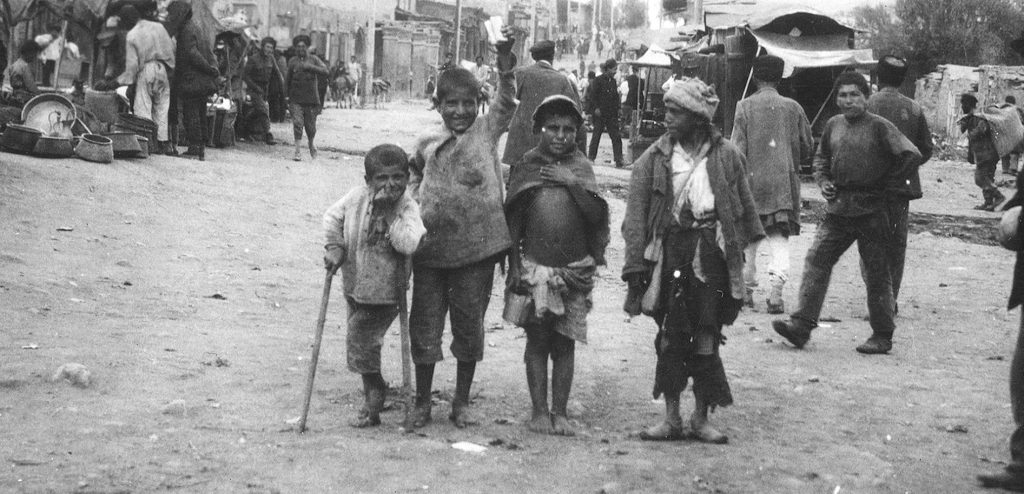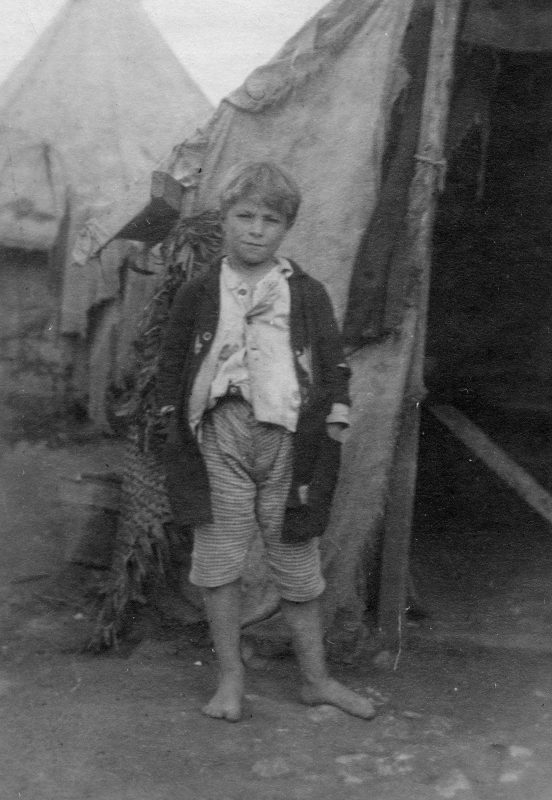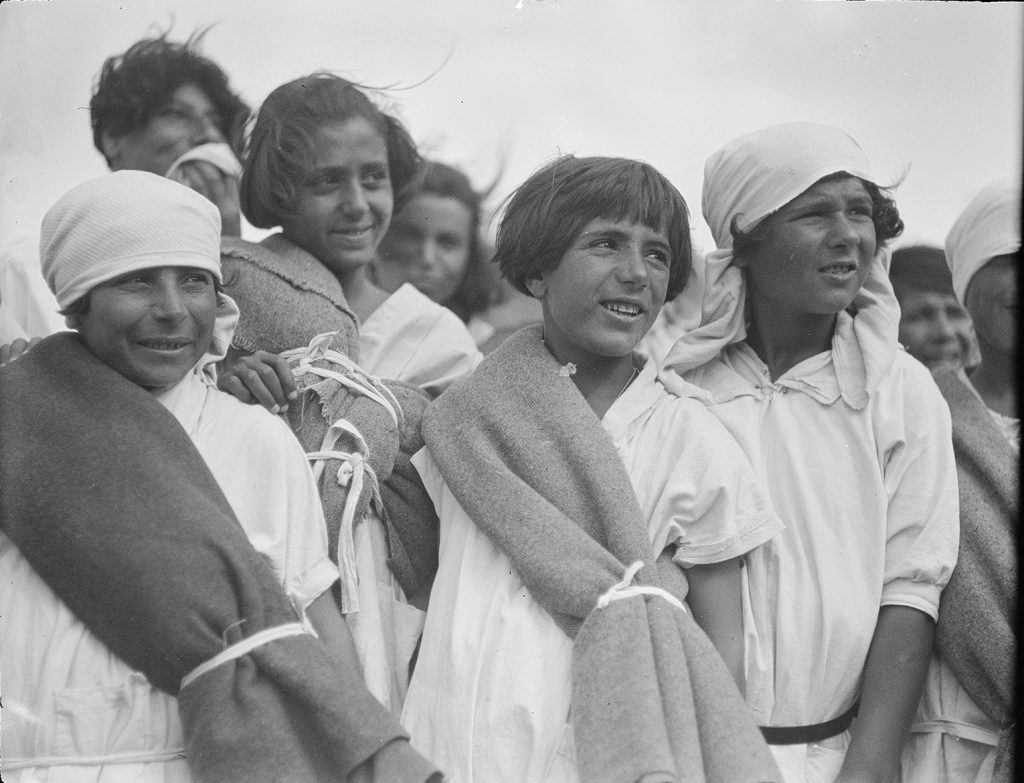SAVING LIVES, SUPPORTING COMMUNITIES: NEAR EAST FOUNDATION AT 101
One hundred and one years ago, a group of businessmen, educators, and philanthropists met in New York City. Their mission: to save the lives of a suffering people in the Near East. At the Near East Foundation, we celebrate our history with an eye toward the future.

Armenian refugee children clothed in rags. One child uses crutches. Probably Armenia, c. 1916.
AN URGENT MESSAGE
It was a matter of life and death. When Cleveland H. Dodge read Ambassador Henry Morgenthau’s urgent telegram to the U.S. Secretary of State, he knew there was no time to lose. Morgenthau’s message from Constantinople was devastating. The now-famous message was nothing less than a personal call to action.
Morgenthau’s historic telegram from September 3, 1915 contained some important unwritten truths. This was not Morgenthau’s first urgent message to the State Department about genocidal acts. The Ambassador had written from Constantinople on July 16, 1915 with a searing description of “a campaign of race extermination” against the Armenian people of Anatolia.
Destruction of Armenian race in Turkey is progressing rapidly. Massacre reported at Angora and Broussa. Will you suggest to Cleveland Dodge, John R. Mott, Stephen Wise and others to form committee to raise funds . . . ?

UNWRITTEN TRUTHS
Secretary of State Robert Lansing‘s response was of little help to the desperate Ambassador. Lansing wrote that “the Department [of State] can offer no additional suggestions relative to this most difficult situation other than that you continue to act as in the past.” Lansing advised Morgenthau to plead with Ottoman Turkish leaders to spare the Armenians’ lives.
These words from the Secretary of State place Morgenthau’s September 3 telegram in an even more interesting historical context. Morgenthau had accepted to a harsh reality. The U.S. government was not going to intervene on behalf of the suffering people in Anatolia.
By asking the State Department to contact individuals like Cleveland H. Dodge and Stephen Wise, Morgenthau voiced his intention that private citizens should step in where the government had failed to act.
In this subtle way, the telegram expressed hope and deep disappointment.
Left: Refugee boy in Beirut, c. 1922.

Ambassador Henry Morgenthau, Samuel Dutton, and Cleveland H. Dodge, c. 1916. Library of Congress.
[T]he deportation as carried out at present is merely a polite form of massacre. Unless the whole movement be stopped at once there is, I am firmly convinced, not the slightest chance of any of the exiles surviving the coming winter, except possibly the very wealthiest among them.

WORDS BECOME ACTIONS
We can only imagine how Cleveland H. Dodge felt when he read his name in the Ambassador’s telegram. Dodge and President Woodrow Wilson had been friends since their days at Princeton University.
A deeply religious man, Dodge also felt a strong personal connection to the Near East. He served as Chairman of the Board of Trustees for Robert College in Constantinople.
Dodge acted quickly and ambitiously. He called a meeting of concerned citizens in his office in Lower Manhattan on September 16, 1915. Dodge joined with longtime missionary Dr. James L. Barton, the progressive Rabbi Stephen Wise, and other men committed to calling attention to the plight of the Armenians.
Dodge was chosen as Treasurer. He quietly informed Secretary Samuel T. Dutton that he, Cleveland H. Dodge, would personally cover all of the Committee’s operating expenses. Every dollar that the public donated would go directly to the relief effort.
Cleveland H. Dodge soon founded the Dodge Foundation, which continues to collaborate with the Near East Foundation to this day.
Left: Article from the Evening News, Wilkes-Barre, PA, 9 Nov. 1915.
When the joint committee which is being organized by Messrs. Crane and Barton meet in New York . . . it will be told that while the United States cannot officially take any part in this relief work, President Wilson will do what he can through Ambassador Morgenthau to persuade the Turkish government to modify its ferocious policy and to end the slaughter in Armenia.

SENDING FUNDS TO CONSTANTINOPLE
The organizers tentatively called their group the Committee Against Armenian Atrocities. The founders pledged $60,000 from their own personal resources at the first meeting They set out to raise funds and awareness in New York City and beyond. Within weeks, local committees were springing up in other cities and towns.
The Committee wired $100,000 to Morgenthau in Constantinople in October 1915. The Ambassador was charged with distributing the funds to the many missionaries that had stayed in the Ottoman Empire despite the declaration of war.
The survivors of the Genocide were mostly women and children. They were living in appalling conditions — especially the thousands of children who had been orphaned by violence, disease, and starvation.
Right: Child refugees in front of a train car. Probably Armenia, c. 1916.
JOINING FORCES
The Committee soon discovered that it was not alone in its concern for the people of the Near East. Several religious groups had already founded the Persian War Relief Fund and the Syria-Palestine Committee. These groups raised funds for persecuted Christians in those regions.
The various committees chose to combine their efforts in order to help even more people. Dodge, Barton, and their colleagues briefly adopted the name Armenian and Syrian Relief Committee before settling on the American Committee for Armenian and Syrian Relief (ACASR).

Orphans at the Near East Relief orphanage in Alexandropol, c. 1919. The new arrivals wear rags.
A UNIQUELY AMERICAN RESPONSE
The Committee launched a public appeal for the incredible amount of $5,000,000 to save the survivors of the Genocide. Americans responded with unprecedented generosity. By the end of 1916, the Committee was feeding and clothing an estimated 500,000 people. Orphans and refugees flocked to relief centers.
In 1919 the Committee received a Congressional charter and adopted a new name: Near East Relief.
Over the course of 15 years, Near East Relief saved more than one million lives. Near East Relief doctors and nurses delivered an estimated 6 million medical treatments. Relief workers provided millions of meals to refugees. But Near East Relief is best known for raising and educating 136,000 children in its vast system of orphanage schools.
Think of that. A generation of children grew up to have lives and families, because Near East Relief called and people responded.

Near East Relief girls with blankets. Date and location unknown.
BUILDING STRONG COMMUNITIES
One hundred and one years after that first meeting, the Near East Foundation (as it has been known since 1930) continues to change lives for the better. NEF’s interdisciplinary programs focus on civic engagement, economic development, and natural resource management.
The original Committee was founded in response to one of the greatest humanitarian crises of all time. More than a century later, the world is engulfed in another refugee crisis. NEF continues to work with refugees, internally displaced people, and other vulnerable populations — as we have for 101 years.
Now is the time to look back at our important past, and to look forward to all that NEF will do in the future.
Let the memory of that first meeting on Sept. 16, 1915 be a renewed call to action for us all.
